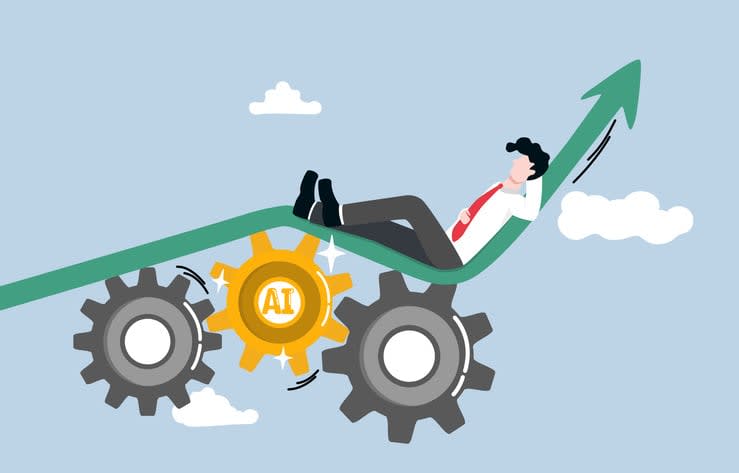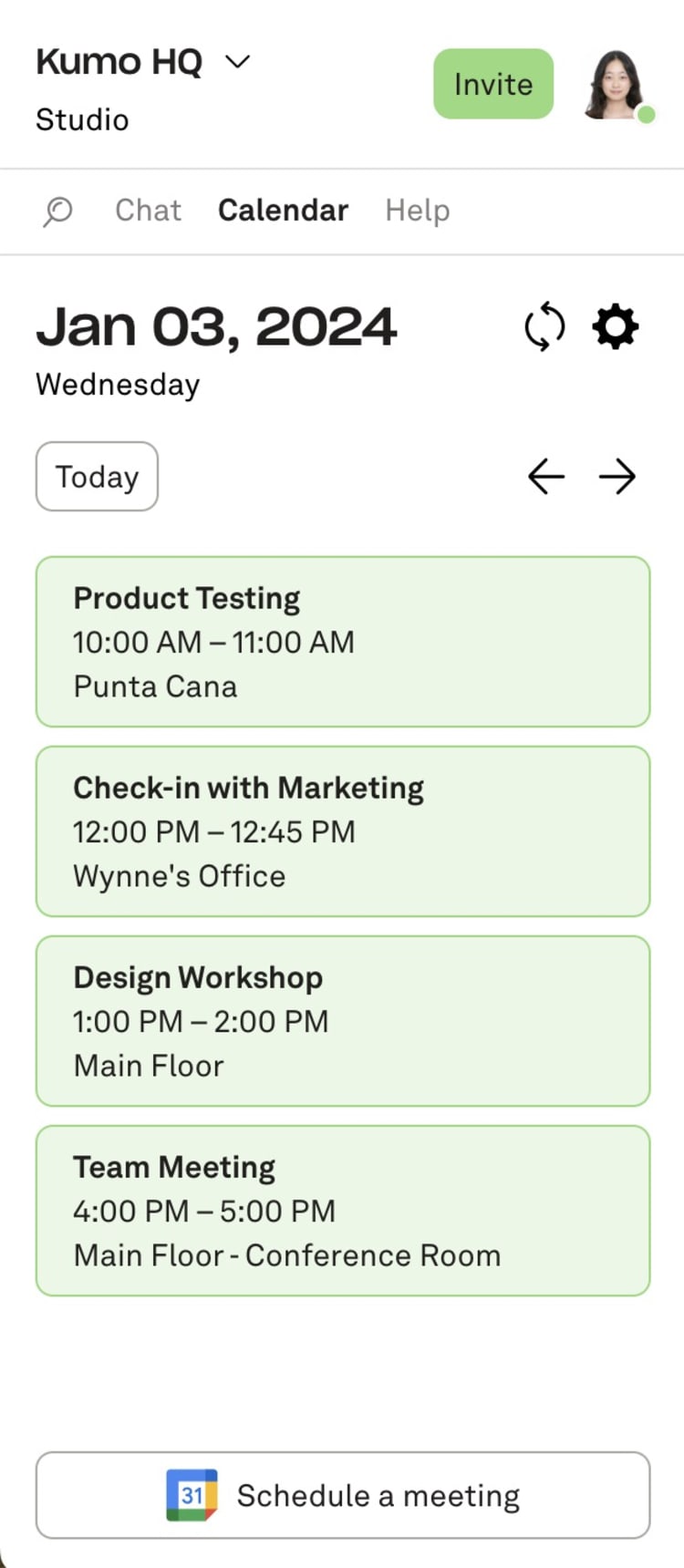Struggling to stay productive? Boost your efficiency with these 10 proven strategies, designed to empower you to achieve more every day. Discover practical tips for a variety of industries, time management hacks, and goal-setting techniques to take your productivity to new heights - all without compromising your mental health.
Key takeaways
- Productivity has evolved from a focus on sheer production to a more nuanced understanding of efficient and wise output, reflecting the changing demands of modern work and life contexts.
- Industry-specific productivity strategies are essential, ranging from adopting technology that simplifies tasks for tech professionals to targeted communication techniques for sales and marketing experts.
- While productivity tools and techniques, such as time management apps and calendar solutions, are important, maintaining a balance between productivity, mental health, and personal well-being is equally crucial for long-term success.
- Implementing Kumospace as a virtual collaboration platform enhances industry-specific productivity strategies by offering an interactive environment that simplifies communication for teams, including tech professionals and sales and marketing experts, while also promoting a balance between productivity, mental health, and personal well-being.
The power of productivity: understanding the concept

Productivity is the capability to yield results, focusing on efficiency and output. But how did this concept evolve? And why is it so crucial in today’s world? In its essence, productivity encapsulates how we harness our skills, knowledge, and tools to produce work of value. It’s about doing more with less, about maximizing our skills and time to achieve the best outcomes. Far from being just a buzzword, productiveness is a crucial life skill that, when understood, can elevate both our personal and professional lives.
The concept of productivity has evolved over time, reflecting changes in our work and life contexts. It is no longer about simply producing; it is about producing wisely and efficiently. This evolution is not a coincidence, but a reflection of our ever-changing world, where demands increase, and resources often remain fixed. Grappling with this concept allows us to tap into its power, stay productive, and achieve our goals.
The origin of "productive"
The term ‘productive’ has an interesting history. It originates from the Medieval Latin word ‘productivus,’ first recorded in 1610, which means ‘fit for production’. The concept of ‘productivity’ emerged two centuries later, initially defined as ‘the quality of being productive’. By the end of the 19th century, the economic implication of ‘productivity’ surfaced, focusing on the ‘rate of output per unit’ that was produced.
This evolution in meaning, a linguistic noun in itself, reflects our increasing focus on efficiency and output, the cornerstones of modern productivity.
Synonyms and antonyms of "productive"
Understanding the synonyms and antonyms of ‘productive’ can further deepen our grasp of the concept. Terms like efficient, effective, fruitful, and lucrative mirror the positive aspects of being productive, highlighting its benefits. Conversely, words like unproductive, ineffective, fruitless, and unprofitable serve as reminders of what happens when productivity is lacking. These antonyms underscore the importance of staying productive to avoid inefficiency and unprofitability.
Industry-specific productivity tips

Grasping the concept of productivity is vital, but it’s just as significant to acknowledge that productivity strategies should be customized to meet the unique challenges and workflows of varying industries.
Whether you’re a writer wrestling with a blank page, a tech professional juggling multiple tasks, or a sales expert striving to meet targets, specific productivity tips can help streamline your work process and enhance your output.
Writers and copywriters
Perfectionism can often be a stumbling block for writers. It stifles creativity by imposing unattainable standards and disrupts the flow of ideas. Instead of striving for perfection in the initial stages, writers are encouraged to write down all ideas, regardless of their perceived imperfections. This approach allows for the refinement and polishing of thoughts and content later.
Moreover, organizing one’s thoughts by writing down tasks, ideas, and insights can significantly enhance productivity. Spontaneous creative insights, when captured, can greatly enhance the quality of writing, as these insights often sow the seeds of high-quality content.
Tech professionals
In the tech industry, the right tools can significantly enhance productivity. Dual monitors or larger screens provide more space for multitasking, enabling tech professionals to work more efficiently. Cloud storage services like Google Docs, Dropbox, or OneDrive allow for seamless access and collaboration on documents from anywhere, ensuring files are always updated and saved automatically.
Moreover, keeping software up to date not only ensures security but often introduces time-saving features, making regular updates a productivity best practice. Applications like Humin can organize contacts based on various factors, saving time in searching for contact information and enhancing networking efficiency.
Programs that limit distractions, like Strict Workflow or segregated browsers, can help maintain focus on work tasks, thereby increasing productivity.
Sales and marketing experts
Sales and marketing professionals also have their unique productivity challenges. Writing shorter, concise emails designed for smartphone-sized message formats can significantly enhance engagement and save time. Choosing to delay or not respond to non-urgent issues can be strategic, saving time and prioritizing more important interactions.
Thorough research on potential buyers enables sales representatives to personalize their messages, making communication more productive. Scheduling short, 15-minute meetings with prospects can make sales interactions more focused and productive. Persistence is key in sales, with research showing that the majority of sales require multiple follow-up calls after the initial meeting.
Tools and techniques for enhancing productivity

Beyond industry-specific tips, there are several general tools and techniques that can enhance productivity. From streamlining repetitive tasks with utilities like CLCL to implementing discipline in a work-from-home setup, these strategies can help manage time effectively and boost productivity.
Time management apps
Time management apps play a pivotal role in organizing and honing daily activities, thereby boosting productivity. For instance, Timecamp offers features such as automated time tracking, invoicing, and team time tracking. Tmetric allows visual timelines and automation via browser add-ons, supporting multiple currencies and tracking by team member.
Applications like RescueTime help eliminate distractions with task-based alerts, website blocking, and health-focused features. Toggl Track facilitates tracking across devices with reminders, idle detection, and third-party integrations. Chrometa automatically captures time spent on tasks, also providing budget monitoring to minimize administrative costs.
AI-powered features in time management tools are advancing, with major platforms like Google and Microsoft incorporating them to fine-tune scheduling and reminders. Some time management applications include goal-setting features and analytical tools to identify productivity patterns and time inefficiencies.
Calendar solutions
Calendar solutions provide an uncomplicated and efficient method to manage time and tasks. Some popular calendar solutions include:
- Google Calendar: Strengthens team coordination through its shared calendars and easy integration with other Google tools.
- Apple Calendar: Provides a seamless user experience on Apple devices.
- Microsoft Outlook Calendar: Preferred in enterprise environments for its robust scheduling capabilities and integration with email and contacts.
Fantastical offers a user-friendly design and intuitive natural-language event creation. Calendar.com allows users to streamline their scheduling by setting available times for others to book appointments. By effectively managing your calendar, you can stay productive and ensure that every minute of your day is used wisely.
Kumospace incorporates calendar solutions by allowing users to schedule and organize virtual meetings and events directly within its platform, integrating with popular calendar systems. This feature streamlines the process of planning and participating in meetings by providing a visual and interactive way to view upcoming events, send invitations, and manage attendees. By integrating these calendar solutions, Kumospace makes it easier for teams to coordinate their schedules, ensuring that productivity and collaboration are enhanced without compromising the balance between work and personal well-being.

Goal-setting strategies
Establishing clear and attainable goals forms a fundamental component of productivity. Concentrating on bite-sized, actionable goals aids in accomplishing broader strategic initiatives. These align with organizational core principles by coordinating daily, weekly, or monthly tasks that support overarching objectives.
Setting goals that are Specific, Measurable, Actionable, Reasonable, and Timely (SMART) ensures a focused approach with clear direction for execution. Motivators such as self-rewards and breaks can enhance motivation and maintain progress toward goal completion.
It’s advisable to segment large tasks into smaller, more manageable steps, allowing gradual and perceptible progress. A balance between productivity, rest, and relationships is critical. Here are some tips to achieve that balance:
- Break down large tasks into smaller, more manageable steps
- Take regular breaks to rest and rejuvenate
- Prioritize relationships and make time for social interactions
- Allow time for creativity and exploration of new ideas
By following these tips, you can maintain a healthy balance between productivity, rest, and relationships.
Kumospace: a platform for efficient collaboration

Collaboration platforms like Kumospace redefine productivity by creating an environment where users can collaborate in a manner that is both efficient and impactful. Kumospace turns the concept of productivity into tangible results, fostering an environment geared towards achieving more with less effort.
Focused workspaces
Kumospace offers customizable workspaces that can be personalized and branded to reflect a company’s culture and tailored to team or project-specific needs. It includes the following features:
- Spatial audio
- Private rooms
- Screen sharing
- Whiteboard
With these features, Kumospace enables multiple conversations, private meetings, and collaborative brainstorms in an immersive virtual environment.
The platform enhances remote team interaction through the following functionalities:
- Pop-out video
- Quick document access
- Flexible virtual movement
- Simultaneous screen presentations
With these features, Kumospace not only facilitates collaboration but also fosters a sense of unity and harmony within the team.
Tangible results
Using Kumospace can lead to tangible results such as:
- Improved team morale
- Streamlined communication
- Team building
- Creative collaboration
- More productive outcomes
Interactive features like virtual rooms and shared whiteboards promote these benefits.
Kumospace transforms traditional, often fatiguing meetings into collaborative and organic conversations that:
- Diminish misunderstandings
- Accelerate idea iteration
- Build trust within teams and across departments
- Facilitate inclusive engagement
- Promote management transparency
The tangible results of productivity with Kumospace are seen in a more engaged workforce, streamlined communication, and a culture of open collaboration.
Redefining productivity
Kumospace is not just a tool; it’s a platform that redefines what being productive means. By providing a virtual office space, Kumospace enhances company culture and aids in uniting global teams.
The platform acts as a remote team’s company home, reflecting team personalities and the overarching brand. As such, Kumospace goes beyond the traditional confines of productivity, offering a fresh, innovative perspective on how we can work more efficiently and effectively.
Real-life examples of productivity success
Real-life examples of successful productivity can provide valuable insights. These examples illustrate how transformative decisions that align with future market trends and organizational growth can lead to significant achievements.
Company president
Company presidents like Arvind Krishna and Satya Nadella exemplify productivity through strategic innovation. Arvind Krishna, as CEO of IBM, directed the company’s focus towards burgeoning sectors like AI, cloud computing, and quantum computing, exemplifying productivity through strategic innovation.
Under Satya Nadella’s leadership, Microsoft’s pivot to cloud services and the shedding of unprofitable acquisitions resulted in an exponential increase in its stock value. This showcases the financial rewards of a productive corporate strategy.
Entrepreneur
Entrepreneurs like Shantanu Narayen showcase productivity success through strategic acquisitions and business model changes. By adopting a subscription-based model and leading strategic acquisitions for Adobe, CEO Shantanu Narayen was at the helm of a twentyfold increase in Adobe’s stock price. This marks a significant achievement in enterprise productivity.
These examples highlight how productivity, when combined with strategic thinking and innovation, can lead to significant business growth and success. They serve as valuable lessons for anyone aiming to boost their productivity, regardless of their field of work.
The importance of balance: productivity and mental health

Striving for productivity is vital, but balancing it with mental health is equally significant. Mental health issues such as depression, anxiety, or ADHD can significantly impair motivation and the ability to perform tasks efficiently. Overemphasis on productivity may negatively affect mental health and life quality.
Recognizing overwhelm
Identifying overwhelm entails comprehending the indicators of mental health disorders or burnout. Some common signs of overwhelm include:
- Cognitive symptoms: trouble concentrating, difficulty staying motivated, and memory problems
- Physical signs: headaches, muscle tension, or stomach problems
- Emotional signs: irritability, mood swings, and a sense of isolation
If you notice any of these signs, it may be a sign that you are feeling overwhelmed and should take steps to address it.
A decline in work performance, such as missing deadlines, making more mistakes, or producing lower-quality work, indicates that overwhelm is negatively impacting productivity. Recognizing these signs early can help individuals seek the support they need and take steps to manage their mental health.
Strategies for maintaining balance
Keeping a balance forms a crucial aspect of managing productivity and mental health. Prioritizing sleep, maintaining a healthy diet, and regular exercise can substantially support mental health and improve overall well-being, while setting boundaries ensures a healthy work-life balance.
Taking regular breaks is necessary for resting the brain and allowing creative ideas to develop, which is particularly beneficial for jobs that require continuous creativity, like copywriting. A balance between productivity, rest, and relationships is critical; rest not only rejuvenates but also enhances future productivity by fostering creativity and providing time for the mind to explore.
Creating a support network with mentors or peers within the workplace can mitigate feelings of being overwhelmed and strengthen resilience against burnout. By integrating these strategies into daily routines, individuals can enhance their productivity while maintaining their mental health.
Summary
To sum up, productivity goes beyond simply getting more done. It’s about working efficiently and effectively, using the right tools and strategies, and maintaining a healthy balance with mental health. Whether it’s adopting specific productivity tips for your industry, utilizing time management apps, or leveraging platforms like Kumospace, there are numerous ways to enhance productivity. By understanding the power of productivity and making it a priority, we can achieve our goals and thrive in our personal and professional lives.
Frequently asked questions
The meaning of being productive lies in making the most out of your time and being efficient and effective with your work. It's not about working long hours but about achieving good results.
Being productive means being able to work efficiently and maximize output within a given time.
Being productive refers to the ability to produce or create something, whether it's work, crops, or positive results in general. It encompasses the power of producing, being generative, and yielding abundant results.
Productivity means the ability to produce results efficiently and effectively.
The symptoms of overwhelm include trouble concentrating, difficulty staying motivated, memory problems, headaches, muscle tension, stomach problems, irritability, mood swings, and a sense of isolation. These symptoms can significantly impact daily life and well-being.





